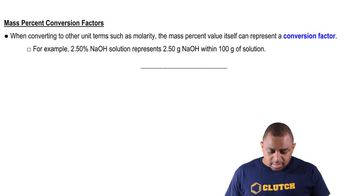Give the empirical formula of each of the following compounds if a sample contains (c) 26.56% K, 35.41% Cr, and 38.03% O by mass.
Ch.3 - Chemical Reactions and Reaction Stoichiometry

Brown14th EditionChemistry: The Central ScienceISBN: 9780134414232Not the one you use?Change textbook
Chapter 3, Problem 46c
Determine the empirical formula of each of the following compounds if a sample contains (c) 89.14% Au and 10.86% O by mass.
 Verified step by step guidance
Verified step by step guidance1
Determine the mass of each element in a 100 g sample based on the given percentages. For Au (gold), it would be 89.14 g, and for O (oxygen), it would be 10.86 g.
Convert the mass of each element to moles by using the atomic masses from the periodic table (Au = 197 g/mol, O = 16 g/mol).
Calculate the mole ratio of Au to O by dividing the moles of each element by the smallest number of moles obtained in the previous step.
If the mole ratio is not a whole number, multiply both ratios by the smallest number that will convert them into whole numbers.
The whole number mole ratios obtained will give the subscripts for each element in the empirical formula. Write the empirical formula by placing these subscripts as the indices of the respective elements.

Verified video answer for a similar problem:
This video solution was recommended by our tutors as helpful for the problem above.
Video duration:
1mWas this helpful?
Key Concepts
Here are the essential concepts you must grasp in order to answer the question correctly.
Empirical Formula
The empirical formula of a compound represents the simplest whole-number ratio of the elements present in that compound. It is derived from the percentage composition of each element, allowing chemists to understand the basic composition without detailing the molecular structure.
Recommended video:
Guided course

Empirical vs Molecular Formula
Molar Mass
Molar mass is the mass of one mole of a substance, typically expressed in grams per mole (g/mol). It is crucial for converting the mass percentages of elements into moles, which are then used to determine the empirical formula by finding the simplest ratio of the elements.
Recommended video:
Guided course

Molar Mass Concept
Conversion from Mass Percent to Moles
To find the empirical formula, the mass percent of each element must be converted to moles. This is done by dividing the mass of each element by its molar mass. The resulting values are then simplified to the smallest whole-number ratio, which gives the empirical formula.
Recommended video:
Guided course

Mass Percent Conversion
Related Practice
Textbook Question
1450
views
Textbook Question
Determine the empirical formula of each of the following compounds if a sample contains (a) 3.92 mol C, 5.99 mol H, and 2.94 mol O
650
views
Textbook Question
Determine the empirical formula of each of the following compounds if a sample contains (b) 12.0 g calcium and 2.8 g nitrogen
769
views
Textbook Question
Determine the empirical formulas of the compounds with the following compositions by mass: (a) 74.0% C, 8.7% H, and 17.3% N
501
views
Textbook Question
Determine the empirical formulas of the compounds with the following compositions by mass: (b) 57.5% Na, 40.0% O, and 2.5% H (c) 41.1% N, 11.8% H, and the remainder S
723
views
Textbook Question
Determine the empirical formulas of the compounds with the following compositions by mass: (a) 42.1% Na, 18.9% P, and 39.0% O (b) 18.7% Li, 16.3% C, and 65.0% O
1243
views
